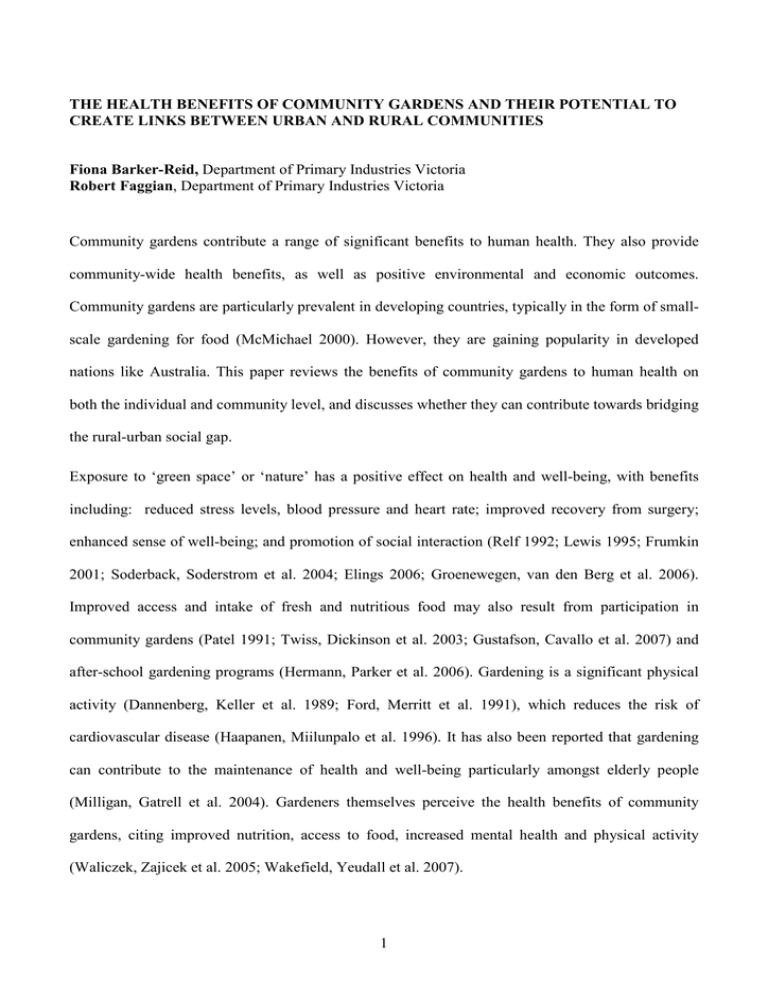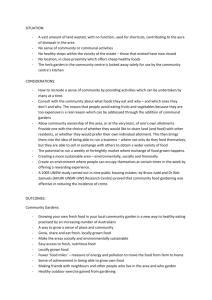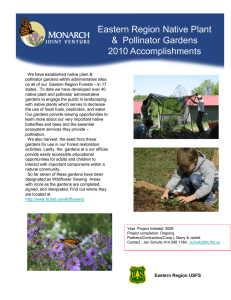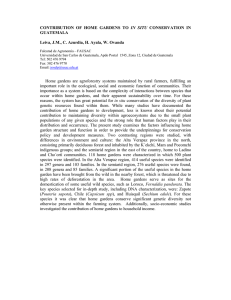THE HEALTH BENEFITS OF COMMUNITY GARDENS AND THEIR POTENTIAL TO
advertisement

THE HEALTH BENEFITS OF COMMUNITY GARDENS AND THEIR POTENTIAL TO CREATE LINKS BETWEEN URBAN AND RURAL COMMUNITIES Fiona Barker-Reid, Department of Primary Industries Victoria Robert Faggian, Department of Primary Industries Victoria Community gardens contribute a range of significant benefits to human health. They also provide community-wide health benefits, as well as positive environmental and economic outcomes. Community gardens are particularly prevalent in developing countries, typically in the form of smallscale gardening for food (McMichael 2000). However, they are gaining popularity in developed nations like Australia. This paper reviews the benefits of community gardens to human health on both the individual and community level, and discusses whether they can contribute towards bridging the rural-urban social gap. Exposure to ‘green space’ or ‘nature’ has a positive effect on health and well-being, with benefits including: reduced stress levels, blood pressure and heart rate; improved recovery from surgery; enhanced sense of well-being; and promotion of social interaction (Relf 1992; Lewis 1995; Frumkin 2001; Soderback, Soderstrom et al. 2004; Elings 2006; Groenewegen, van den Berg et al. 2006). Improved access and intake of fresh and nutritious food may also result from participation in community gardens (Patel 1991; Twiss, Dickinson et al. 2003; Gustafson, Cavallo et al. 2007) and after-school gardening programs (Hermann, Parker et al. 2006). Gardening is a significant physical activity (Dannenberg, Keller et al. 1989; Ford, Merritt et al. 1991), which reduces the risk of cardiovascular disease (Haapanen, Miilunpalo et al. 1996). It has also been reported that gardening can contribute to the maintenance of health and well-being particularly amongst elderly people (Milligan, Gatrell et al. 2004). Gardeners themselves perceive the health benefits of community gardens, citing improved nutrition, access to food, increased mental health and physical activity (Waliczek, Zajicek et al. 2005; Wakefield, Yeudall et al. 2007). 1 Community gardens also provide benefits to the broader community. These include the building of stronger, more cohesive communities, development of support networks, reduced levels of violence, and increased levels of community pride (Relf 1992; Sullivan and Kuo 1996; Armstrong 2000). Furthermore, such gardens provide access to nature, which is known to increase neighbourhood satisfaction (Relf 1992). Community gardens, as a form of urban agriculture, can also create opportunities for leadership development and community organising, therefore contributing to the development of social capital (Brown and Jameton 2000). WinklerPrins (2004) goes further and provides evidence that community gardens can provide an important means of sustaining critical social networks between urban and rural communities. Similarly, support and tolerance of agriculture is stronger when non-farmers report the existence of social capital with farmers (Sharp and Smith 2003). Can community gardens therefore provide even wider benefits by bridging the divide between urban and rural communities in Australia? The recent proliferation of community gardens, combined with growing interest in ‘food miles’, locally-grown food, and other concepts around the amelioration of climate change impacts, indicate that they do. References: Armstrong, D. (2000). "A Survey of Community Gardens in Upstate New York: Implications for Health Promotion and Community Development." Health and Place 6(4): 319-327. Brown, K. H. and A. L. Jameton (2000). "Public Health Implications of Urban Agriculture." Journal of Public Health Policy 21(1): 20-39. Dannenberg, A. L., J. B. Keller, et al. (1989). "Leisure time physical activity in the Framingham offspring study." American Journal of Epidemiology 129(1): 76-88. Elings, M. (2006). People-Plant Interaction. Farming for Health. J. Hassink and M. van Dijk. Netherlands, Springer: 43-55. Ford, E. S., R. K. Merritt, et al. (1991). "Physical Activity Behaviors in Lower and Higher Socioeconomic Status Populations." American Journal of Epidemiology 133(12): 1246-1256. 2 Frumkin, H. (2001). "Beyond toxicity: Human health and the natural environment." American Journal of Preventative Medicine 20(3): 234-240. Groenewegen, P., A. van den Berg, et al. (2006). "Vitamin G: effects of green space on health, wellbeing, and social safety." BMC Public Health 6(1): 149. Gustafson, A., D. Cavallo, et al. (2007). "Linking homegrown and locally produced fruits and vegetables to improving access and intake in communities through policy and environmental change." Journal of the American Dietetic Association 107: 584-585. Haapanen, N., S. Miilunpalo, et al. (1996). "Characteristics of Leisure Time Physical Activity Associated with Decreased Risk of Premature All-Cause and Cardiovascular Disease Mortality in Middle-aged Men." American Journal of Epidemiology 143(9): 870-880. Hermann, J. R., S. P. Parker, et al. (2006). "GEM No 412: After-school gardening improves children's reported vegetable intake and physical activity." Journal of Nutrition Education and Behavior 38: 201-202. Lewis, C. A. (1995). "Human health and well-being: the psychological, physiological, and sociological effects of plans on people." Acta Horticulturae (ISHS) 391: 31-40. McMichael, A. J. (2000). "The urban environment and health in a world of increasing globalization: issues for developing countries." Bulletin of the World health Organization 78(9): 1117-1126. Milligan, C., A. Gatrell, et al. (2004). "'Cultivating health': therapeutic landscapes and older people in northern England." Social Science and Medicine 58(9): 1781-1793. Patel, I. C. (1991). "Gardening's socioeconomic impacts." Journal of Extension 29(4). Relf, D. (1992). "Human Issues in Horticulture." HortTechnology 2(2). Sharp, J. S. and M. B. Smith (2003). "Social capital and farming at the rural-urban interface: the importance of nonfarmer and farmer relations." Agricultural Systems 76(3): 913-927. Soderback, I., M. Soderstrom, et al. (2004). "Horticultural therapy: the 'healing garden' and gardening in rehabilitation measures at Danderyd hospital rehabilitation clinic, Sweden." Developmental Neurorehabilitation 7(4): 245-260. Sullivan, W. C. and F. E. Kuo (1996). Do trees strengthen urban communities, reduce domestic violence? Forestry Report R8-FR 56, University of Illinois. Twiss, J., J. Dickinson, et al. (2003). "Community Gardens: Lessons Learned from California Healthy Cities and Communities." American Journal of Public Health 93(9): 1435-1438. Wakefield, S., F. Yeudall, et al. (2007). "Growing urban health: Community gardening in South-East Toronto." Health Promotion International 22(2): 92-101. Waliczek, T., J. Zajicek, et al. (2005). "The influence of gardening activities on consumer perceptions of life satisfaction." HortScience 40(5): 1360-1365. 3 WinklerPrins, A. M. G. A. (2004). "House-lot gardens in Santarém, Pará, Brazil: Linking rural with urban." Urban Ecosystems 6(1-2): 43-65. 4




